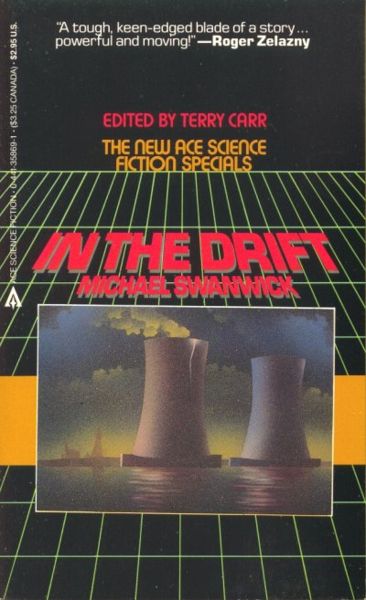Your Heart Will Glow
In the Drift
By Michael Swanwick

9 Aug, 2022
Michael Swanwick’s 1985 In the Drift is a stand-alone near-future alternate-history novel. In the Drift was the sixth1 novel in the Third Ace Science Fiction Specials series, edited by Terry Carr.
1979: in a spectacular exhibition of American nuclear industry know-how, Three Mile Island suffered a catastrophic melt-down. A vast swath of land downwind of the reactor was contaminated with radioactive debris. This is the so-called Drift. Millions fled, only to be violently murdered by their fearful fellow Americans. The USA splintered.
Almost a century later, the east coast is still a shambles but only some of it glows in the dark.
When Philadelphia’s conventional civil government collapsed, the Mummers stepped in. Eschewing the complexities of democratic rules, the Mummers provide the city with an interlinked cabal of oligarchs, supported by a rank and file made up mostly of the well connected and ambitious. Violence is one of the Mummers’ go-to tools, whether murdering disabled persons as so-called “mutants” or executing persons foolish enough to be inconvenient to the Mummers. It’s a simple system but it works.
Philadelphia is run by Italians and Irish, leaving Poles like Keith Piotrowicz out in the cold. Keith’s competence marks him as a possible exception. For the moment, however, Keith has no interest in the Mummers beyond maintaining sufficiently friendly relations to avoid being one of their targets.
This changes when Keith encounters reporter Suzette Fletcher. Keith’s meeting with Fletcher proves ill-advised. The outsider knows something about Philadelphia the Mummers want kept secret. Fletcher is marked for death. Keith’s proximity to Fletcher may mean he knows what she knows. Keith must die too.
Survival inspires Keith to fully embrace Mummer politics: safer to be inside, with some say over events to come, than being outside and unprotected. This leads to Keith’s managerial role in an ambitious Drift resettlement program, a bold scheme that will provoke war with the Greenstate Alliance, uprising within the Drift, and the rise of a messianic figure conventional methods are ill-suited to handle.
~oOo~
One of the risks of retrospective projects like this is encountering details it might have been better to remember before starting. Partway into the book I remembered that this book is more of a fix up than a planned-from-the start novel.
Normally I’d tackle each section as its own story. In this case, since many of the characters are hardcore racists fond of the n‑word, one of the major sections uses the n‑word in the title. I don’t want that slur front-and-center on my site, so I’m tackling the book as a whole.
I am not sure one can get Chernobyl results from an American pressurized light-water reactor. Have fun discussing this in comments!
The appearance later in the novel of mutants with extraordinary sensory powers suggests that Swanwick was not obsessed with scientific or technological plausibility; those are less important than writing an exciting story.
Speaking as a Canadian, the novel’s assessment of Americans seems unduly pessimistic even in light of the last six years. In the Drift embraces a rather gloomy worldview: a single nuclear crisis not only provokes the US into homicidal attacks on American refugees2, causes the Balkanization of the nation, and sets off a century-long recession, but it also causes Canada to divide for some reason and seems to have hit pause on the global economy and technological progress. Is Pennsylvania that important to the global economy3?
In the Drift began as the 1981 novelette Mummer’s Kiss, first published in Terry Carr’s Universe 11. Mummer’s Kiss was nominated for a Nebula; it is not surprising that the expansion is well written and has memorable characters. However, the book falls down structurally. Swanwick does not manage the jump from novelette to novel, instead opting for an episodic structure covering several decades. Consequently, while the Third Ace Specials were supposed to be first novels, In the Drift has far more in common with fix-ups like Pavane than it does with Wild Shore or Neuromancer. Ah, well.
In the Drift is available here (Amazon US), here (Amazon Canada), here (Amazon UK), here (Barnes & Noble), here (Book Depository), and here (Chapters-Indigo).
1: Wait, you ask, wasn’t the previous review in this series of the fourth Third Ace Science Fiction Specials novel, Palimpsests? What happened to the fifth book? That fifth book was Howard Waldrop’s Them Bones, and I reviewed it way back in 2014. I’ve amended its entry to make it clear that Them Bones was one of the Third Ace Science Fiction Specials.
2: As is so often the case with 1980s SF, one wonders if this irrationally violent reaction to the potentially radioisotope-contaminated is an AIDS metaphor?
3: It may be that conventional fuel shortages were part of the problem, given that a good chunk of the plot has to do with the “last surviving hunk of anthracite in North America.” There are many SF works from this period that expected fossil fuels to peter out around 2000 AD. I noted that it is a plot point that despite the TMI disaster, reactors remained in use in the US well past their designed lifespans, which would suggest that alternatives were not readily at hand.
